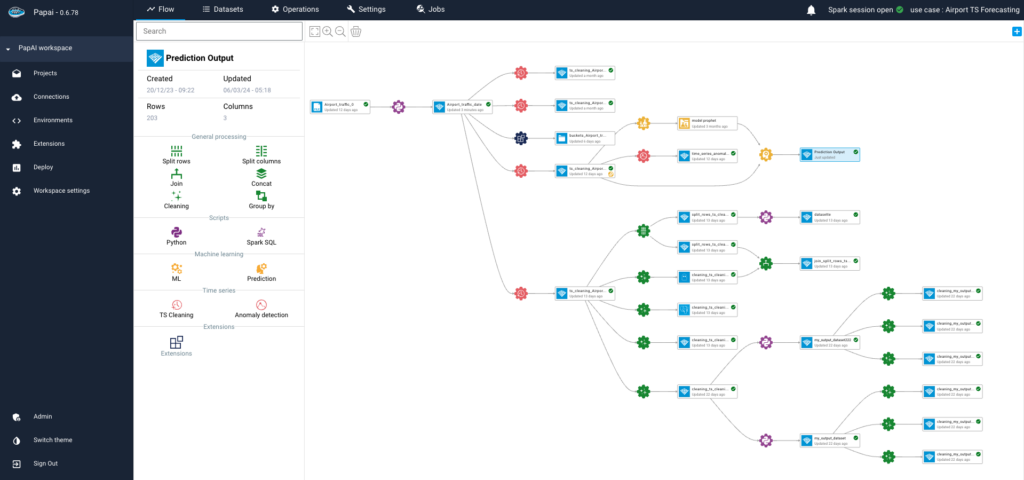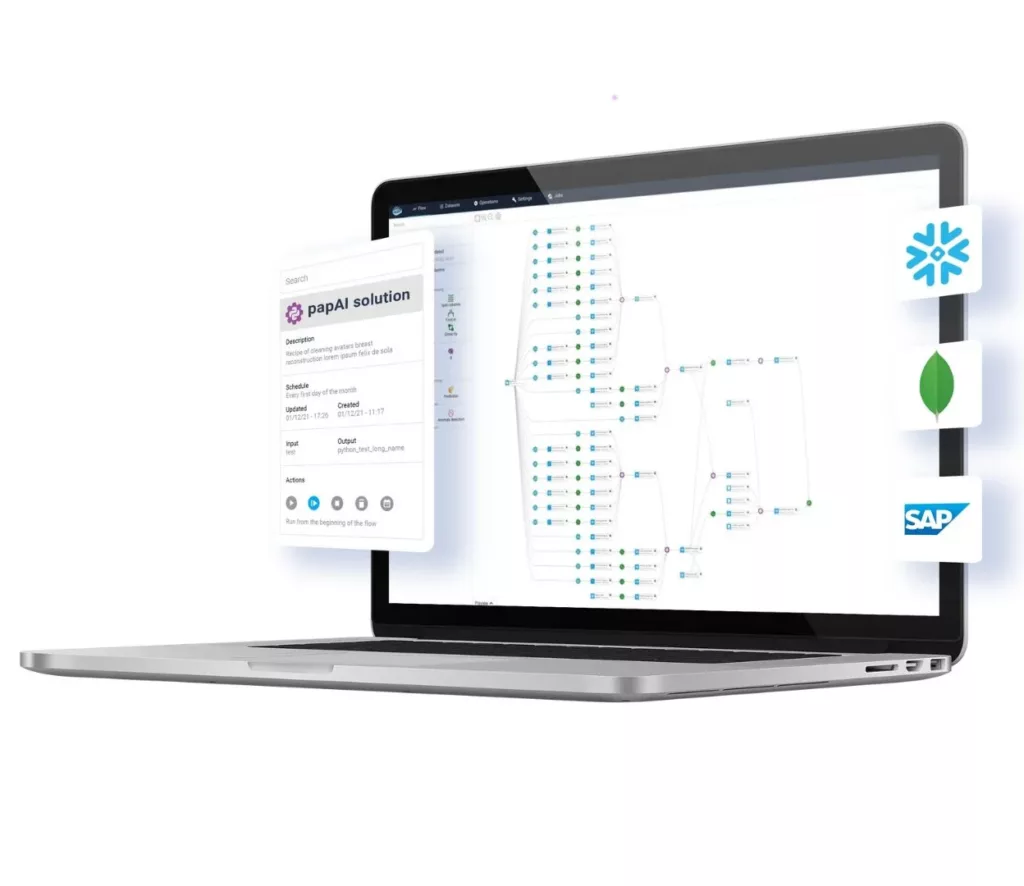How Law Firms Use RAG to Boost Legal Research RAG...
Read MoreDecoding AI Solutions:
SaaS vs On-Prem vs Hybrid
Table of Contents
ToggleSaaS vs On-Prem vs Hybrid, the choice of your AI solution can be very complex. In this context, you need to follow certain criteria: the size of your organization, your in-house AI maturity, and your budget. Striking the right balance between these criteria guarantees a tailor-made AI solution that is perfectly aligned with your company’s objectives requires a good knowledge of these offers.

In this article, we will examine the primary distinctions among these three proposals and how you can comprehend their benefits.
Trends Shaping AI in 2024
1- Checking Reality: More Reasonable Expectations Business executives now have a deeper knowledge of generative AI than just marketing jargon as it advances. According to the Gartner Hype Cycle, generative AI is poised to enter the “Trough of Disillusionment” after reaching the “Peak of Inflated Expectations.” According to Deloitte’s analysis, there will be significant short-term revolutionary effects.
2- Multimodal AI: AI systems are becoming more and more common and can process and comprehend many kinds of data, including text, photos, and videos. More thorough and contextually aware interactions are made possible by multimodal models.
3- Smaller Language Models and Open Source Developments: There are now more effective foundation models available under open licenses. Despite having fewer parameters, many models—such as the LlaMa family from Meta and others—can perform better than proprietary models.
4- GPU Shortages and Cloud Costs: Research and development have been impacted by the GPU shortages brought on by the need for AI training. Companies are also struggling with growing cloud computing expenses related to AI workloads.
On-Premise: Tailoring AI in interne
Description
One smart and calculated way to incorporate AI into an organization’s operational structure is through the On-Premise AI deployment strategy. Unlike other cloud-based systems, all of the AI software, algorithms, and apps in this architecture are housed on the actual servers and hardware of the business.
Businesses are able to directly manage their computing resources thanks to this local deployment, which offers a unique degree of control and autonomy over the AI environment. Dedicated and secure environments are provided for the implementation of AI processes by on-premise solutions, which provide a unique on-site ecosystem.
This strategy entails setting up and maintaining AI infrastructure on the company’s property, which frequently necessitates a thorough comprehension of the internal IT environment. The networking infrastructure required to enable the AI applications is also deployed, in addition to the computing components. With on-premise solutions, businesses may adopt a highly customized and regionalized approach to artificial intelligence because all data is stored, and processed, and AI algorithms are executed inside.
Advantages
Selecting On-Premise AI solutions has many benefits and is customized to meet the unique requirements and tastes of discriminating companies. The greatest benefit of these is the customization that On-Premise models provide. Businesses now have the freedom to adjust models and algorithms so that AI applications perfectly suit their particular set of needs. In contrast to cloud-based systems, On-Premise installations provide businesses total control over the AI infrastructure, making it easier to customize models to fit particular workflows and procedures.
Enhanced data protection is another essential benefit of on-premise systems. A crucial component of the decision-making process is the local hosting of AI processes in companies where data protection and regulatory compliance are top priorities.
Organizations may enforce stringent data management measures using On-Premise models, therefore mitigating their vulnerability to external attacks. This feature is especially appealing to industries like government, healthcare, and finance where protecting sensitive data is not only a legal requirement but also a top concern.
Ideal Companies?
On-premise AI systems are best suited for certain company environments, especially bigger ones with more substantial IT departments. The on-premise option is frequently preferred by sectors like banking, healthcare, and government where data sensitivity and compliance are crucial factors. For companies that prioritize autonomy and a localized approach to AI integration, On-Premise solutions are the best option since they offer complete control over the AI infrastructure, from customization to security protocols.
SaaS Mode for more Flexibility
Description
The software delivery environment has completely changed thanks to Software as a Service (SaaS), a dynamic and cutting-edge deployment approach. When it comes to artificial intelligence (AI), software as a service (SaaS) refers to the internet-based subscription-based delivery of AI services and applications.
Users may access AI features through a web browser, which eliminates the need for local installs and offers a smooth, on-demand experience, in contrast to traditional software installations. SaaS mode is a popular choice for companies looking for effective AI solutions without the hassle of complex infrastructure administration because of its well-known accessibility, scalability, and ease of integration.
AI services are hosted and managed by a third-party provider under the SaaS model, usually on cloud platforms. By streamlining the user experience, this method enables businesses to leverage artificial intelligence (AI) without having to deal with the headaches associated with developing, maintaining, and updating software.
A user-friendly interface is usually used by users to access a variety of AI tools and applications, such as machine learning algorithms and natural language processing. Businesses may now exploit cutting-edge technology without requiring specialized internal knowledge thanks to the democratization of AI, which creates new opportunities for creativity and competitiveness.
Advantages
The SaaS approach does away with the requirement for large upfront expenditures on software and hardware infrastructure. Organizations may successfully manage their budget by paying only for the services they utilize using the subscription-based pricing model.
Smaller companies with limited capital resources will find this cost-effective strategy especially tempting as it allows them to access advanced AI capabilities without the financial burden of on-premise solutions.
Additional benefits of the SaaS model include its quick deployment and upgrades. Businesses can keep up with technology breakthroughs by quickly integrating new AI capabilities and upgrades without any interruptions. This adaptability is essential in the ever-changing AI landscape because it enables organizations to innovate and adjust to new trends and demands from the competition.
Ideal Companies?
Due SaaS mode offers flexible solutions that can be tailored to meet a variety of needs and preferences, it is particularly well-suited for a wide range of businesses. SaaS mode offers access to advanced AI capabilities without requiring substantial in-house IT resources, which is why small and medium-sized businesses (SMEs) frequently find it to be particularly advantageous. SaaS’s scalability enables SMEs to increase their AI usage naturally in line with company growth.
Moreover, entrepreneurs may use SaaS to swiftly incorporate AI features into their goods or services, as they may have limited resources and must focus on getting to market rapidly. Startup settings are dynamic and adaptable, and SaaS’s flexibility and cost-effectiveness fit very nicely.
Hybrid Mode: A Perfect Combination
Description
The hybrid method of AI deployment presents a flexible and strategic approach by integrating aspects of both cloud-based and on-premise systems. This deployment architecture makes use of the cloud’s scalability and accessibility for some AI features while hosting others locally.
With the agility and scalability of cloud services combined with the customization and control of on-premise solutions, hybrid mode is meant to provide organizations with the best of both worlds. By balancing their distinct operational demands, organizations may maximize the effectiveness of their AI applications thanks to this hybrid design.
Certain AI procedures and data may be maintained on-premise under the hybrid approach, guaranteeing a high degree of protection and control. In the meantime, other parts can make use of cloud-based services, which provide scalability and flexibility, particularly during moments of high demand. By combining the benefits of both on-premise and cloud settings, this combination serves companies with a wide range of needs and can adapt to the subtleties of their operations. It’s an advanced strategy that lets businesses adjust on the fly to changing demands.
Advantages
The flexibility that the hybrid form of AI deployment gives in meeting a variety of organizational demands and issues is the foundation for its benefits. The ability to customize the AI infrastructure to meet particular needs is one of the main benefits. While less sensitive or resource-intensive operations can use cloud resources for increased scalability, critical and sensitive procedures should be retained on-premises to ensure maximum control, compliance, and data protection.
Additionally, the hybrid mode provides a scalable solution without requiring significant expenditures in on-premise equipment. Without the limitations of a fully on-premise architecture, businesses may optimize their AI resources flexibly, scaling up or down based on demand. Businesses with changing workloads or those in seasonal sectors will find this scalability especially useful.
Ideal Companies?
The hybrid mode, which combines the benefits of on-premise management with the scalability of the cloud, is ideal for businesses that want a customized and flexible AI solution. By keeping important operations on-site and using cloud services for less sensitive duties, it enables companies to balance efficiency and data protection.
Find the Offer that's Right for your Needs with papAI Platform

“As the product owner of papAI, I am thrilled to offer a transformative solution that not only streamlines the deployment and industrialization of AI and data science projects but also provides a huge flexibility with SaaS, Hybrid, and On-Premise deployment options, empowering organizations to tailor their AI journey according to their unique needs and strategic goals.”
Thibaud Ishacian
Product Owner at Datategy
Overview of papAI Solution
As a complete and advanced End-to-End AI solution, papAI is unique in that it acts as a driving force behind the smooth implementation and industrialization of data science and AI initiatives. The fundamental purpose of papAI is to simplify the whole AI project lifecycle by offering a single platform that breaks down conventional boundaries between development, deployment, and cooperation.
This solution, which includes state-of-the-art technology, collaborative features, and a suite of tools for effective project execution, is painstakingly created to equip organizations with an all-encompassing approach to AI.

One of the standout features of papAI is its ability to simplify and accelerate the deployment of AI and data science projects. By offering a unified platform, it bridges the gap between development and deployment, eliminating silos and bottlenecks in the process.
This streamlining significantly reduces the time and resources required for project completion, enabling organizations to realize the benefits of AI solutions faster than traditional approaches.
Flexible papAI deployment options: SaaS, hybrid and On-premise
In addition to its powerful AI capabilities, papAI sets itself apart by providing a variety of deployment choices that meet the various demands and preferences of enterprises. This deployment flexibility is a reflection of papAI’s dedication to adaptation, guaranteeing that companies can easily incorporate its cutting-edge capabilities into their current infrastructure. SaaS, Hybrid, and On-Premise deployment formats are among the many possibilities offered by papAI. These models let organizations to select the deployment approach that best suits their operating needs.

An on-premise AI solution refers to deploying artificial intelligence infrastructure within an organization’s physical premises, offering maximum control and security over AI processes. Achieving an on-premise AI solution involves implementing and maintaining AI software, algorithms, and applications locally, ensuring data processing and model execution are performed within the organization’s dedicated environment.
Using a cloud-based Software as a Service approach, artificial intelligence capabilities may be accessed through SaaS AI solutions. This method does not require local installs because users utilizse AI functions via the internet. In order to implement a SaaS AI solution, one must subscribe to the platform of a service provider. This allows for the easy and scalable integration of cutting-edge AI technologies without the hassle of maintaining on-premise infrastructure.
The advantages of both on-premises and cloud-based models are combined in a hybrid AI system, providing a flexible and customized method of implementing artificial intelligence. To achieve optimum control and security, this entails carefully implementing specific AI processes on-premise while leveraging the cloud for scalability and flexibility.
Interested in discovering papAI?
Our AI expert team is at your disposal for any questions
How RAG Systems Improve Public Sector Management
How RAG Systems Improve Public Sector Management The most important...
Read MoreScaling RAG Systems in Financial Organizations
Scaling RAG Systems in Financial Organizations Artificial intelligence has emerged...
Read MoreHow AgenticAI is Transforming Sales and Marketing Strategies
How AgenticAI is Transforming Sales and Marketing Strategies Agentic AI...
Read More


